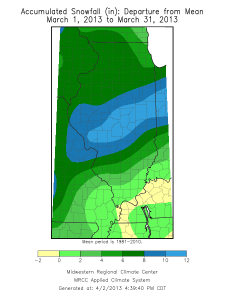Based on preliminary data, March 2014 in Illinois was cold and dry.
Temperature
The statewide average temperature was 33.8 degrees, which was 7 degrees below average and the 8th coldest March on record. Combined with the colder-than-average January and February made this the 4th coldest start (23.6 degrees) for Illinois for the year to date.
This was the fifth month in a row with temperatures much below average in Illinois. At this point, it was the second coldest November-March on record for Illinois at 29.1 degrees. See the bar graph below showing monthly temperature departures since January 2013.
If this cold March felt familiar, it was because last March was cold as well. The statewide average temperature for March 2013 was only 34.1 degrees.

Precipitation
The statewide average precipitation was 1.49 inches, which strangely enough was 1.49 inches below average and the 11th driest on record. The statewide average precipitation last March was much higher at 2.74 inches. Eight out of the last nine months have had below-average precipitation. As a result, the statewide precipitation departure since July 1 was 7.2 inches.

The first map below is the accumulated precipitation for March (rain plus the water content of any snow event). Most of the state received between 1 to 2 inches of precipitation. It was wettest in the far south and driest in the northwest.
The second map shows the precipitation departures from average for March, showing all areas of the state with below-average precipitation. This would be of more concern if March had been warm. However, with the colder conditions very little drying took place.
Snowfall
The third map shows the snowfall for March. Amounts were in the 1 to 5 inch range in the southern half of the state and 5 to 15 inches or more in the northern half. Mendota reported the highest monthly total of 17.9 inches.
The fourth map shows the snowfall departure from average for March. The entire state was above-average on snowfall for the month. While it seems like a contradiction to report above-average snowfall and below-average precipitation for March, it really is not. The problem is that we have had few rainfall events in March, which was unusual. So we ended up with a lot of snow but the water content of all that snow did not make up for the lack of rain. 



 The good news of sorts is that much of the upper Midwest, including northern Illinois has been dry for the last 3-4 months. In the last few weeks, what snow cover we had in the central US is gone, as this map shows.
The good news of sorts is that much of the upper Midwest, including northern Illinois has been dry for the last 3-4 months. In the last few weeks, what snow cover we had in the central US is gone, as this map shows.










